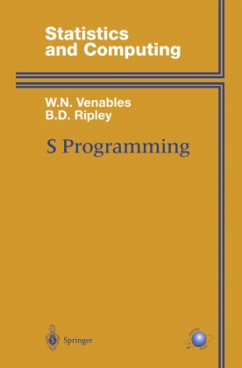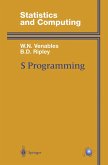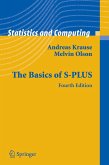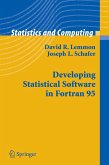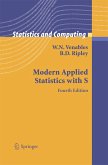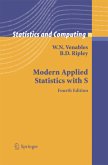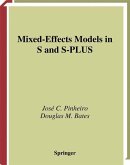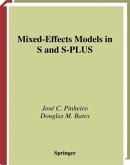S is a high-level language for manipulating, analysing and displaying
data. It forms the basis of two highly acclaimed and widely used data
analysis software systems, the commercial S-PLUS® and the Open
Source R. This book provides an in-depth guide to writing software in
the S language under either or both of those systems. It is intended
for readers who have some acquaintance with the S language and want to
know how to use it more effectively, for example to build re-usable
tools for streamlining routine data analysis or to implement new
statistical methods.
One of the outstanding strengths of the S language is the ease with
which it can be extended by users. S is a functional language, and
functions written by users are first-class objects treated in the same
way as functions provided by the system. S code is eminently readable
and so a good way to document precisely what algorithms were used, and
as much of the implementations are themselves written in S, they can be
studied as models and to understand their subtleties. The current
implementations also provide easy ways for S functions to call
compiled code written in C, Fortran and similar languages; this is
documented here in depth.
Increasingly S is being used for statistical or graphical analysis
within larger software systems or for whole vertical-market
applications. The interface facilities are most developed on
Windows® and these are covered with worked examples.
The authors have written the widely used Modern Applied Statistics
with S-PLUS, now in its third edition, and several software libraries
that enhance S-PLUS and R; these and the examples used in both books
are available on the Internet.
Dr. W.N. Venables is a senior Statistician with theCSIRO/CMIS
Environmetrics Project in Australia, having been at the Department of
Statistics, University of Adelaide for many years previously.
Professor B.D. Ripley holds the Chair of Applied Statistics at the
University of Oxford, and is the author of four other books on spatial
statistics, simulation, pattern recognition and neural networks. Both
authors are known and respected throughout the international S and R
communities, for their books, workshops, short courses, freely
available software and through their extensive contributions to the
S-news and R mailing lists.
Hinweis: Dieser Artikel kann nur an eine deutsche Lieferadresse ausgeliefert werden.
data. It forms the basis of two highly acclaimed and widely used data
analysis software systems, the commercial S-PLUS® and the Open
Source R. This book provides an in-depth guide to writing software in
the S language under either or both of those systems. It is intended
for readers who have some acquaintance with the S language and want to
know how to use it more effectively, for example to build re-usable
tools for streamlining routine data analysis or to implement new
statistical methods.
One of the outstanding strengths of the S language is the ease with
which it can be extended by users. S is a functional language, and
functions written by users are first-class objects treated in the same
way as functions provided by the system. S code is eminently readable
and so a good way to document precisely what algorithms were used, and
as much of the implementations are themselves written in S, they can be
studied as models and to understand their subtleties. The current
implementations also provide easy ways for S functions to call
compiled code written in C, Fortran and similar languages; this is
documented here in depth.
Increasingly S is being used for statistical or graphical analysis
within larger software systems or for whole vertical-market
applications. The interface facilities are most developed on
Windows® and these are covered with worked examples.
The authors have written the widely used Modern Applied Statistics
with S-PLUS, now in its third edition, and several software libraries
that enhance S-PLUS and R; these and the examples used in both books
are available on the Internet.
Dr. W.N. Venables is a senior Statistician with theCSIRO/CMIS
Environmetrics Project in Australia, having been at the Department of
Statistics, University of Adelaide for many years previously.
Professor B.D. Ripley holds the Chair of Applied Statistics at the
University of Oxford, and is the author of four other books on spatial
statistics, simulation, pattern recognition and neural networks. Both
authors are known and respected throughout the international S and R
communities, for their books, workshops, short courses, freely
available software and through their extensive contributions to the
S-news and R mailing lists.
Hinweis: Dieser Artikel kann nur an eine deutsche Lieferadresse ausgeliefert werden.
From the reviews: JOURNAL OF THE AMERICAN STATISTICAL ASSOCIATION "Let me come right to the point. If you use S at all - either through the S-PLUS commercial software package or its free open software variant - get this book. It is a superbly written, indispensable resource to the S language. Whether you merely dabble in S/R (or are contemplating such dabbling) or are a seasoned veteran who uses it extensively, you will find [this book] invaluable¿I would be remiss if I did not pay homage to what I consider a most welcome feature of this book: the superb quality of the writing and the remarkable attention to detail by both authors and publisher. V&R write clearly and very concisely; they take great care to explain what needs to be explained, but they do not patronize the reader with trivialities; they use many well chosen examples and code snippets to support their expositions; and they organize and sequence topics logically, and extensively and liberally cross-reference them by page number to help the reader understand how they relate. Finally, V&R frequently take pains to point out lurking software traps and documentation inaccuracies that can plague users. I consider such conscious efforts to mitigate future aggravations for readers a thoughtful courtesy that more software documenters should emulate. I also would like to compliment the publishers on the superb typography and page layout that clearly distinguishes text, code, tables, section headings, and so forth. The editing is also remarkable: I noticed no errors at all! This level of attention to production detail makes the book very easy to either browse or study. I appreciated it very much. In many respects, [this book] could serve as a model for what ought to be the standard in software references. It strikes a careful and effective balance between providing a big picture of the overall language structure and the details necessary to fit the pieces together and make them work.

